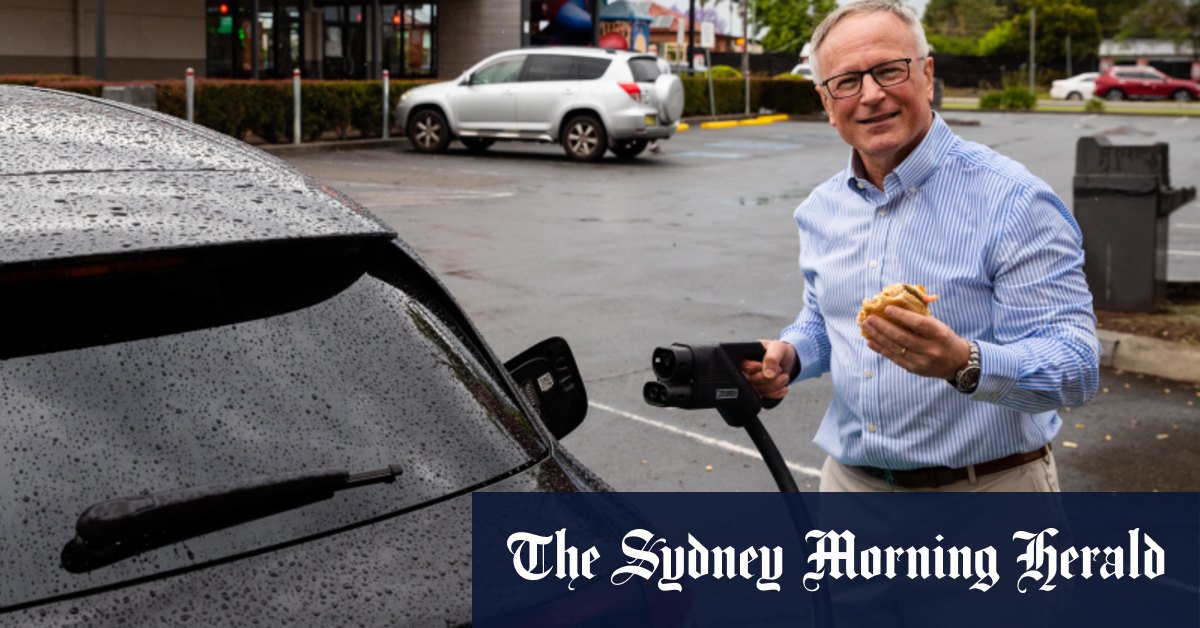Mills says that Evie Networks operates 110 charging stations in Australia, with plans to grow to 150 by July and 250 by the end of the year.
But charging stations aren’t set up quickly, he says, each taking 18 months to design, approve, supply and build.
Evie Networks boss Chris Mills advises EV drivers taking long Easter trips to plan for congestion at charging stations.Credit:Bloomberg
The number of public charging stations has nearly doubled in Australia in the last three years, according to the Electric Vehicle Council, with almost 5,000 charging points available in December last year, up from 3,413 in 2021.
More are expected to roll out at service stations in the coming months following announcements by BP and Ampol, while leading electric car maker Tesla has opened up more of its Supercharger network to other car brands in Australia.
Australian Electric Vehicle Association national president Chris Jones says many Tesla drivers will be using those charging locations over Easter.
He predicts the biggest lines for the festivities will occur hundreds of miles beyond state capitals.
Charging
“About 300 kilometers outside of any major city is where you’ll see the most demand,” he says.
“It’s likely to end up somewhere like Tenterfield relative to Brisbane, or Coffs Harbor relative to Sydney. It will be roughly one charge difference from a capital city, and that is where there will be 10 to 15 people lining up to use the same charger at the same time of day.”
But one problem that has been addressed since Christmas, Mills says, is the reliability of existing chargers.
He says the initial “range anxiety” of owning an electric vehicle, concerns about how far it will travel on a battery charge, is morphing into “reliability anxiety,” or concerns about whether the nearest charging station it will work.
Mills says Evie Networks has stocked spare parts and will be assigning staff over Easter to ensure chargers are up and running or repaired quickly, avoiding unnecessary queues.
“Drivers will drive past charging stations that aren’t sure they’re ready and available to use a charging station,” he says.
“If you are in doubt about whether or not a charging station will be available, it will stop 100km early while you still have 20 percent of your battery left.”
Jane Hunter, chief executive of Australian charging equipment giant Tritium, says the design of the company’s latest charging stations is also helping operators repair and maintain their investments faster.
Charging
Tritium’s newer charging stations featured a modular design, he says, so parts can be attached and removed for quick repairs.
The addition is vital to make the most of existing stations and keep more vehicles on the road at peak times.
“If you have a five percent charge and you get to a charger that hasn’t held up, it’s disastrous for you,” says Hunter.
According to Jones, Australia’s more than 83,000 EV drivers should also use the days leading up to an Easter road trip to plan ahead and consider alternatives to using a public charger, if possible.
“If you’re going to stay in a motel, when you book say, ‘Hey, I’d like to charge my electric vehicle overnight, can you give me a room near the charging point?’
“In Albany (WA), there are a couple of motels that have charging points and people choose to stay there for that reason.”
He says drivers should recharge early in the morning or late at night to avoid peak demand and check to see if chargers are already being used in apps like PlugShare before arriving at a location.
-AAP

